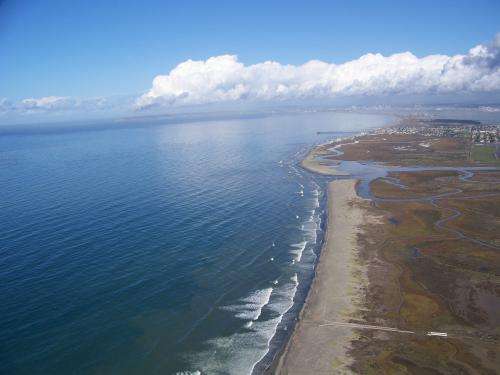Tijuana River along the California-Mexico border is one of the areas where climate change impacts are being measured in NOAA's National Estuarine Research Reserve System. Credit: NOAA Tijuana River NERR
The nation's 28 National Estuarine Research Reserves (NERR) are experiencing the negative effects of human and climate-related stressors according to a new NOAA research report from the National Ocean Service.
The national study, Climate Sensitivity of the National Estuarine Research Reserve System, points to three East Coast reserves, Sapelo Island NERR in Georgia, ACE Basin NERR in South Carolina and Waquoit Bay NERR in Massachusetts, and the Tijuana River NERR on the California-Mexico border, as the most sensitive to climate change.
"The National Estuarine Research Reserves are uniquely positioned across the U.S. to assess ongoing climate change in our nation's estuaries which is the degree to which the natural resources and the local communities who depend on them are affected by changing climate conditions," said Dwight Trueblood, Ph.D. a co-author and NOAA program manager for the study. "This information is important to helping coastal managers and local community leaders make informed decisions about the best ways for coastal communities to adapt to climate change."
Estuaries are places where rivers meet the sea, providing nursery habitat for fish and shellfish while buffering many coastal communities from the impacts of coastal storms and sea level rise. The climate exposure of each reserve provides first alarm indicators about the effects of climate change on the coastal ecosystems. Ongoing research at each of the reserves provides real-time data about how climate change impacts these important natural resources.
Almost 40 percent of all Americans, or about 123 million people, live in the counties directly along the shoreline and depend on these resources for food, jobs, storm protection, and recreation. Approximately 50 percent, or $6.6 trillion, of the nation's gross domestic product comes from coastal watershed counties which support more than 51 million jobs.
Researchers determined the extent of relative climate sensitivity in the reserves by looking at five factors: social, biophysical, and ecological sensitivity, and exposure to temperature change and sea level rise.
Key Findings
Reserve ecological resilience was examined and the key underlying estuarine stressors were found to be toxic pollutants, storm impacts, invasive species, habitat fragmentation, sedimentation and shoreline erosion. The most frequently identified factors contributing to these stressors included residential development, land use, population growth, wastewater treatment and sea level rise.
High social sensitivity to climate change was indicated where there is higher employment within natural resource-dependent industries, lower per capita income and median home values, higher percentages of minority populations, and a higher percentage of individuals lacking a high school education.
- Social sensitivity to climate change was generally highest in the southern portions of the East and West coasts of the U.S., the Gulf of Mexico and Alaska.
- Biophysical sensitivity summarizes each reserve's relationship between annual spring atmospheric temperature and rainfall data and water quality factors such as water temperature, dissolved oxygen and pH.
- Temperature change exposure risk was greatest for reserves located in the Great Lakes, Gulf of Mexico, Mid-Atlantic, and Northeast regions of the country, while reserves in the Gulf of Mexico, parts of the Mid-Atlantic, Southeast, California, and Oregon showed the greatest risk of sea level rise exposure.
More information: www.nerrs.noaa.gov/Doc/PDF/Research/130725_climate%20sensitivity%20of%20nerrs_Final-Rpt-in-Layout_FINAL.pdf
Provided by NOAA Headquarters





















